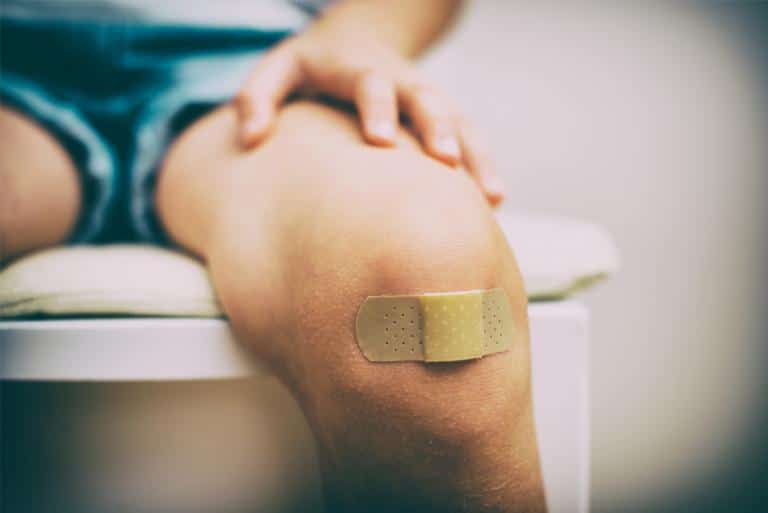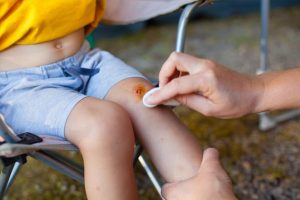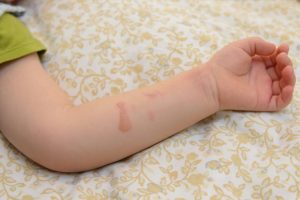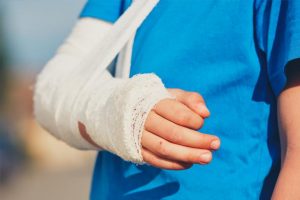Injuries in Children
Managing Common Childhood Injuries

Important Items Your First Aid Box Should Have
- Bandages of various sizes
- Sterile cotton wool and gauze
- Melonin dressing
- Steri-strip to bring small cuts on the skin surface together
- Antiseptic solution
- Clinical thermometer
- Clean scissors and forceps
- Safety pins
You could also consider including medicines like paracetamol, flu and diarrhoea medications. If you are not sure about what medications you should include, you should check with your PD. They will also advise you on the correct doses.
How to Perform First Aid Treatment for Injuries?
Now that you have your first aid kit, it is important to know how to use it. Here is a guide on how to handle common childhood injuries.

For simple cuts and abrasions, you can wash and clean the affected area with water and antiseptic solution. Then you can apply a dry dressing. You should change the dressing once every 3-4 days to ensure the wound heals properly.
If the cut is large or deep, then you should visit a doctor who will treat the wound according to the severity of the wound. While the initial bleeding may seem scary, applying pressure on the wound with your hands can keep the bleeding in control even for larger wounds.

Young children are naturally curious therefore they might try and touch items around them that might not be safe. Some of these items might result in them burning or scalding themselves but there are certain measures you can put in place to ensure this does not happen. Read more on what are the common types of burns in children and precautions you can take to prevent these types of injuries from taking place.

Children often sustain fractures while they are playing. While the fractured limb may be clearly swollen or injured, there are some situations where your child may just complain about pain in their limbs. Regardless, you should bring your child to see a doctor as the severity of the fracture can only be determined after an X-ray.
Keep in mind that you should avoid letting your child eating or drinking anything until they are seen by the doctor as they might need to undergo anaesthesia to get their fracture fixed.
This usually happens when your children’s fingers are caught in the door hinges or when doors are accidentally closed on their fingers. It also occurs when children try to poke their fingers in household appliances or even sockets.
A Steristrip dressing can be done to reposition the wound. In more serious cases, partial or complete finger amputation or severely crushed fingers would require emergency surgery.
This injury is usually caused if there is a sudden pull on your child’s arm, typically when you swing them while playing or grab them to prevent them from falling. Your child will most likely complain of pain and will not use the injured arm. This can be easily fixed by your doctor.
Children usually sustain head injuries if they fall off beds, sofas and chairs or even while they are playing.
Fortunately, most head injuries are not severe but it is still recommended to visit your doctor to ensure the injury is not serious as sometimes children may have fractured their skull fractures or sustained internal brain injuries.
Some symptoms that indicate your child’s head injury is serious includes drowsiness, vomiting, bleeding from the ears or nose and if your child is unconscious.
If your child has accidentally swallowed an object, they may complain of throat pain. You should seek medical attention immediately.
It is common for children to accidentally inhale food when they laugh or talk as they eat and if they eat while they are lying down. Furthermore, young children are unable to control their swallowing reflex properly yet. One of the most common food items that are inhaled is nuts. If your child is 3 years and below, you should strictly not allow him/her to eat or play with nuts.
If your child inhales objects or food, the item can cause obstruction in their windpipe. Therefore you seek medical attention immediately. If your baby turns blue or becomes unconscious you should immediately call the ambulance. While waiting for medical help to arrive, you should turn your baby prone on your lap and apply 4 back-blows on his/her back in the area between the shoulder blades to dislodge the inhaled object.
For older children who turn blue or become unconscious, you can use the Heimlich manoeuvre to dislodge the inhaled object. This can be lifesaving.
If your child has ingested or is suspected to have swallowed something poisonous, you should seek medical attention as soon as possible. Do not try to force him into vomiting or attempt a home remedy. If your child is unconscious, immediately call for an ambulance and place him/her on their stomach to prevent him from choking in case he/she starts to vomit.
Even if your child does not show any signs of distress, you should still seek medical advice immediately as the effects of the poison may not manifest until much later.
If you can, bring the poison your child ingested in its original container to the doctor. Your doctor can use it to check the exact ingredients in the poison your child ingested.
If it is a simple injury where particles such as sand or dirt have gotten into your children’s eyes, they can be removed easily by cleaning their eyes with clean tap water. Do not use a cloth to rub their eyes as this may irritate the eye further.
If it is a penetrating eye injury or a chemical substance has gotten into your child’s eye, it is vital to seek medical attention immediately. For chemical substances that have gotten into your children’s eyes, the very first thing you should do apart from seeking medical attention is to hold their face upwards and under a running tap for at least 5 minutes.
If there is an object stuck in your child’s ear or nose, do not try to remove it as there is a risk of pushing the object further in instead. You should seek medical attention as soon as possible so that the doctor can remove the object safely.
Conclusion
When handling common childhood injuries, it is key for parents to be calm and carefully think through the next steps they should take. If you are calm, your child will also be calm. You should administer basic first aid where possible and seek medical attention immediately if the injury is more serious. You should also keep a list of all the emergency numbers for easy reference.

